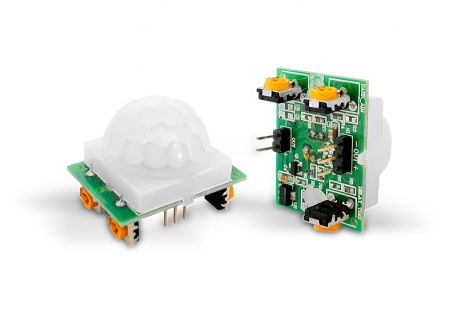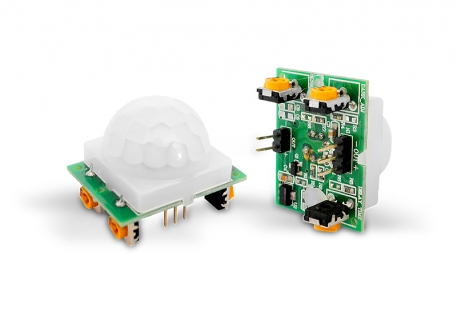[ESP]
¡Bienvenidos a una nueva entrega sobre módulos electrónicos! 🌟
Hoy exploraremos el sensor de movimiento PIR, una herramienta clave en sistemas de detección de movimiento y automatización.
📌 ¿Qué es el sensor PIR?
El sensor PIR (Passive Infrared) detecta cambios en los niveles de radiación infrarroja en su entorno, permitiendo identificar movimiento en un área determinada. Es ampliamente utilizado en proyectos como alarmas, luces automáticas y sistemas de seguridad.

🛠️ Características principales
- Rango de detección: Aproximadamente 7 metros.
- Ángulo de detección: ~120°.
- Voltaje de operación: 5V a 12V.
- Salidas: Digital (HIGH/LOW).
- Aplicaciones: Seguridad, automatización del hogar, y más.
💻 Conexión básica del módulo PIR a Arduino

🔧 Ejemplo de código en Arduino
A continuación, un ejemplo básico para detectar movimiento y activar un LED:

💡 Nota: Ajusta el tiempo de espera y sensibilidad del PIR según tus necesidades, usando los potenciómetros integrados en el módulo.
🌟 Aplicaciones comunes
- 1️⃣ Sistemas de seguridad: Detección de intrusos en hogares o edificios.
- 2️⃣ Automatización de luces: Activación de luces solo cuando se detecta movimiento.
- 3️⃣ Control de dispositivos electrónicos: Automatización en sistemas IoT.
- 4️⃣ Proyectos educativos: Aprendizaje de sensores y sistemas de control.
⚠️ Consideraciones importantes
- Calibración inicial: El sensor tarda unos segundos en estabilizarse tras encenderlo.
- Evitar interferencias: Instálalo lejos de fuentes de calor o luz directa para evitar falsas detecciones.
- Cobertura adecuada: Asegúrate de ubicarlo en un ángulo que maximice su rango efectivo.
🚀 Conclusión
El módulo PIR es una herramienta sencilla pero poderosa que puede transformar tus proyectos con funcionalidades de detección de movimiento. Su integración con microcontroladores lo convierte en un recurso esencial en la automatización y la seguridad.
📢 ¡Gracias por acompañarme en este recorrido sobre el módulo PIR! 💡
Espero que esta publicación te motive a utilizarlo en tus proyectos. Si tienes dudas o experimentos que compartir, ¡déjame un comentario! 📝
🔔 No olvides nuestras próximas publicaciones, donde exploraremos más módulos y aplicaciones prácticas. 🌐
🤝 Únete a la comunidad en Hive para aprender, colaborar y compartir tus logros en electrónica. 💬
🌟 Sigue creando: Lleva tus ideas al siguiente nivel con herramientas y conocimientos innovadores. ¡Hasta la próxima! 🚀✨
[ENG]
Welcome to a new installment on electronic modules! 🌟
Today we will explore the PIR motion sensor, a key tool in motion detection and automation systems.
📌 What is the PIR sensor?
The PIR (Passive Infrared) sensor detects changes in infrared radiation levels in its environment, allowing movement to be identified in a given area. It is widely used in projects such as alarms, automatic lights, and security systems.

🛠️ Main features
- Detection range: Approximately 7 meters.
- Detection angle: ~120°.
- Operating voltage: 5V to 12V.
- Outputs: Digital (HIGH/LOW).
- Applications: Security, home automation, and more.
💻 Basic connection of the PIR module to Arduino

🔧 Arduino code example
Here is a basic example to detect motion and activate an LED:

💡 Note: Adjust the PIR timeout and sensitivity to your needs, using the potentiometers built into the module.
🌟 Common Applications
- 1️⃣ Security Systems: Intrusion detection in homes or buildings.
- 2️⃣ Light Automation: Activating lights only when motion is detected.
- 3️⃣ Electronic Device Control: Automation in IoT systems.
- 4️⃣ Educational Projects: Learning about sensors and control systems.
⚠️ Important Considerations
- Initial Calibration: The sensor takes a few seconds to stabilize after powering on.
- Avoid Interference: Install it away from heat or direct light sources to avoid false detections.
- Adequate Coverage: Make sure to place it at an angle that maximizes its effective range.
🚀 Conclusion
The PIR module is a simple yet powerful tool that can transform your projects with motion detection capabilities. Its integration with microcontrollers makes it an essential resource in automation and security.
📢 Thanks for joining me on this tour of the PIR module! 💡
I hope this post motivates you to use it in your projects. If you have questions or experiments to share, leave me a comment! 📝
🔔 Don't forget our upcoming posts, where we'll explore more modules and practical applications. 🌐
🤝 Join the community on Hive to learn, collaborate, and share your electronics achievements. 💬
Thanks for your contribution to the STEMsocial community. Feel free to join us on discord to get to know the rest of us!
Please consider delegating to the @stemsocial account (85% of the curation rewards are returned).
You may also include @stemsocial as a beneficiary of the rewards of this post to get a stronger support.
♦️ You got 0.01 FELT for sharing high vibes on Hive.
📋♦️ FELT Info
Genial. great
Brilliant post! 🌈